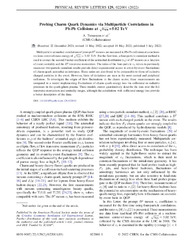Probing charm quark dynamics via multiparticle correlations in Pb-Pb collisions at √s NN = 5.02 TeV
| dc.contributor.author | Tumasyan, A. | |
| dc.contributor.author | Işıldak, Bora | |
| dc.date.accessioned | 2023-06-16T12:10:10Z | |
| dc.date.available | 2023-06-16T12:10:10Z | |
| dc.date.issued | 2022-07-05 | |
| dc.identifier.issn | 0031-9007 | en_US |
| dc.identifier.uri | http://hdl.handle.net/10679/8433 | |
| dc.identifier.uri | https://journals.aps.org/prl/abstract/10.1103/PhysRevLett.129.022001 | |
| dc.description.abstract | Multiparticle azimuthal correlations of prompt D0 mesons are measured in Pb-Pb collisions at a nucleon-nucleon center-of-mass energy of sNN=5.02 TeV. For the first time, a four-particle cumulant method is used to extract the second Fourier coefficient of the azimuthal distribution (v2) of D0 mesons as a function of event centrality and the D0 transverse momentum. The ratios of the four-particle v2 values to previously measured two-particle cumulant results provide direct experimental access to event-by-event fluctuations of charm quark azimuthal anisotropies. These ratios are also found to be comparable to those of inclusive charged particles in the event. However, hints of deviations are seen in the most central and peripheral collisions. To investigate the origin of flow fluctuations in the charm sector, these measurements are compared to a model implementing fluctuations of charm quark energy loss via collisional or radiative processes in the quark-gluon plasma. These models cannot quantitatively describe the data over the full transverse momentum and centrality ranges, although the calculations with collisional energy loss provide a better description of the data. | en_US |
| dc.description.sponsorship | BMBWF and FWF (Austria); FNRS and FWO (Belgium); CNPq, CAPES, FAPERJ, FAPERGS, and FAPESP (Brazil); MES and BNSF (Bulgaria); CERN; CAS, MoST, and NSFC (China); MINCIENCIAS (Colombia); MSES and CSF (Croatia); RIF (Cyprus); SENESCYT (Ecuador); MoER, ERC PUT and ERDF (Estonia); Academy of Finland, MEC, and HIP (Finland); CEA and CNRS/IN2P3 (France); BMBF, DFG, and HGF (Germany); GSRI (Greece); NKFIA (Hungary); DAE and DST (India); IPM (Iran); SFI (Ireland); INFN (Italy); MSIP and NRF (Republic of Korea); MES (Latvia); LAS (Lithuania); MOE and UM (Malaysia); BUAP, CINVESTAV, CONACYT, LNS, SEP, and UASLP-FAI (Mexico); MOS (Montenegro); MBIE (New Zealand); PAEC (Pakistan); MSHE and NSC (Poland); FCT (Portugal); JINR (Dubna); MON, RosAtom, RAS, RFBR, and NRC KI (Russia); MESTD (Serbia); MCIN/AEI and PCTI (Spain); MOSTR (Sri Lanka); Swiss Funding Agencies (Switzerland); MST (Taipei); ThEPCenter, IPST, STAR, and NSTDA (Thailand); TUBITAK and TAEK (Turkey); NASU (Ukraine); STFC (United Kingdom); DOE and NSF (USA). | |
| dc.language.iso | eng | en_US |
| dc.publisher | American Physical Society | en_US |
| dc.relation.ispartof | Physical Review Letters | |
| dc.rights | openAccess | |
| dc.rights.uri | https://creativecommons.org/licenses/by/4.0/ | |
| dc.title | Probing charm quark dynamics via multiparticle correlations in Pb-Pb collisions at √s NN = 5.02 TeV | en_US |
| dc.type | Article | en_US |
| dc.description.version | Publisher version | en_US |
| dc.peerreviewed | yes | en_US |
| dc.publicationstatus | Published | en_US |
| dc.contributor.department | Özyeğin University | |
| dc.contributor.authorID | (ORCID 0000-0002-0283-5234 & YÖK ID 124605) Işıldak, Bora | |
| dc.contributor.ozuauthor | Işıldak, Bora | |
| dc.creator | The CMS Collaboration | |
| dc.identifier.volume | 129 | en_US |
| dc.identifier.issue | 2 | en_US |
| dc.identifier.wos | WOS:000824635900006 | |
| dc.identifier.doi | 10.1103/PhysRevLett.129.022001 | en_US |
| dc.identifier.scopus | SCOPUS:2-s2.0-85135202250 | |
| dc.relation.publicationcategory | Article - International Refereed Journal - Institutional Academic Staff |
Files in this item
This item appears in the following Collection(s)
Share this page




